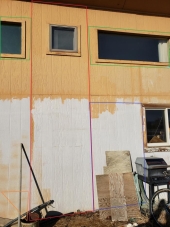Just so I understand where everyone is coming from, what are seen to be the good points of earthships that are being kept or augmented?
For my own part, I need to try to keep my mind from shutting off whenever anyone starts talking Earthships because of the tire angle. There's just too much labour involved in packing tires with earth, to no purpose.
In my climate, for instance, I have heard that insulated concrete forms installed and used to contain rammed earth, mixed by truck or large mixer and tamped down by motorised tamper, would do the job better and more quickly than ramming tires full of earth with a sledgehammer. If the earth mix is amended to include 10 percent portland or quick lime, the structure takes on properties much closer to poured concrete.
I would design my structure to support the requisite weight, drop a moisture barrier, backfill around and atop the structure with largely mineral topsoil and cap with another water impermeable barrier for moisture control and for structural integrity of the earth pile, and drop a few tonnes of subsoil, topsoil, and perennial pasture and oak savannah analogue species.
An idea that I want to play with, but I could see easily backfiring, is using light wells through the earth topping, sealed from the top, and accessible through the bottom for cleaning and maintenance, and capping those light wells with forest pools. The pools themselves, in the lightly forested pasture savannah I am looking to create, would not only serve the typical purpose of ponds in forests, but would also, with a domed cap on the light tube at the bottom of each pond, stay clear of sediment and would bring light into the structure. I wouldn't expect to get enough light this way for indoor gardens, but that's what the southward-facing windows, or more than likely, four-season lean-to greenhouse entryway would be for.
The greenhouse would house tropicals and a permaculture-aligned
aquaculture setup that would likely include an overwinter nursery for my outdoor pond culture systems. Greywater would run through the beds, and the resultant clean water would then go into the aquaculture, which would also filter through the greywater setup, further feeding the occupant plants.
So I have kept the earth part of the earthship, because I feel that utilising in-situ resources is a smart idea where possible.
I am keeping the structure ground-connected, as while the walls would be insulated, the floor wouldn't be, and that's where I would put my ground-sourced heat pump, which would pass hot air and hot waste water over heat exchangers using a high-capacity heat transfer fluid, which would deposit the heat energy in the soil column below, which would create its own heat island under the dirt umbrella outside the insulated concrete forms used to contain the rammed earth walls.
I was thinking that I could dig one "heat well," wherein a column of earth would be insulated, such that the heat would be trapped and stored for use in the winter, where the heat pump would move that excess into the living space at need. This could easily be augmented with black ducting in the direct winter sun path of the greenhouse, heating air in the black duct, which would heat the system. In the summer, the ductwork would simply move excess hot air to the same place, but would be shaded from the summer sun.
The greywater/food producing year-round indoor planter garden and integrated aquaculture have been retained.
And I have, with the dirt umbrella and on-grade construction with living roof, incorporated some of my favourite elements of wofati and hobbit holes.
Have I missed anything that any reasonable person would consider necessary in order to call it an earthship, or am I describing something so far removed from what was originally envisioned that we need a new name for it?
And to the original issue, how much can reasonably be altered for such a structure to still apply as an earthship, and are there any core ideas that must be retained, or the intent of the original idea be lost?
-CK
A human being should be able to change a diaper, plan an invasion, butcher a hog, conn a ship, design a building, write a sonnet, balance accounts, build a wall, set a bone, comfort the dying, take orders, give orders, cooperate, act alone, solve equations, analyze a new problem, pitch manure, program a computer, cook a tasty meal, fight efficiently, die gallantly. Specialization is for insects.
-Robert A. Heinlein





 1
1








 1
1





















